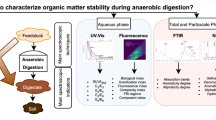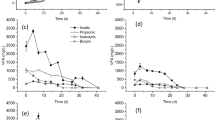Abstract
Organic matter contained in food waste was degraded by anaerobic digestion under mesophilic and thermophilic conditions at two hydraulic retention times. Evolution of the digestion process was followed by thermogravimetry analysis, fluorescence spectroscopy and 1H nuclear magnetic resonance. All analytical methods suggested that longer retention times might be required for food waste stabilization under mesophilic conditions as compared to thermophilic stabilization. All the analytical methods showed that the stabilization process consisted of two steps, where complex organic molecules were formed during initial stabilization and then digested providing sufficient hydraulic retention time. Longer hydraulic retention times were required for food waste stabilization under mesophilic conditions. Overall, thermal and 1H NMR analyses of the digestate samples might be recommended if more detailed analysis is required, while fluorescence measurements can be used as a fast screening technique, which provides qualitative assessment of the stabilization process.








Similar content being viewed by others
References
Chen Y, Cheng JJ, Creamer KS (2008) Inhibition of anaerobic digestion process: a review. Bioresour Technol 99:4044–4064
Lo KV, Liao PH, March AC (1985) Thermophilic anaerobic digestion of screened dairy manure. Biomass 6:301–315
Smidt E, Lechner P (2005) Study on the degradation and stabilization or organic matter in waste by means of thermal analyses. Thermochim Acta 438:22–28
Balmer P, Kaffehr B (1981) Differential thermal analysis for the characterization of the stability of sludge. In: L’Hermite P, Ott H (eds) Characterization, treatment and use of sewage sludge, proceedings of the 2nd European Symposium, Reidel, Dordrecht/Boston/London, 1981 Vienna, 21–23 October 1980
Dell’Abate MT, Canali S, Trinchera A, Benedetti A, Sequi P (1998) Thermal analysis in the evaluation of compost stability: a comparison with humification parameters. Nutr Cycl Agroecosyst 51:217–224
Dell’Abate MT, Benedetti A, Brookes PC (2003) Hyphenated techniques of thermal analysis for characterisation of soil humic substances. J Sep Sci 26:433–440
Otero M, Calvo LF, Estrada B, García AI, Morán A (2002) Thermogravimetry as a technique for establishing the stabilization progress of sludge from wastewater treatment plants. Thermochim Acta 389:121–132
Klammer S, Knapp B, Insam H, Dell’Abate MT, Ros M (2008) Bacterial community patterns and thermal analyses of composts of various origins. Waste Manag Res 26:173–187
Pons MN, Le Bonté S, Potier O (2004) Spectral analysis and fingerprinting for biomedia characterisation. J Biotechnol 113:211–230
Miano TM, Senesi N (1992) Synchronous excitation fluorescence spectroscopy applied to soil humic substances chemistry. Sci Total Environ 117:41–51
Baker A, Inverarity R, Charlton M, Richmond S (2003) Detecting river pollution using fluorescence spectrophotometry: case studies from the Ouseburn, NE England. Environ Pollut 124:57–70
Řezáčová V, Gryndler M (2006) Fluorescence spectroscopy: a tool to characterize humic substances in soil colonized by microorganisms. Folia Microbiol 51:215–221
Chen J, LeBoeuf EJ, Dai S, Gu B (2003) Fluorescence spectroscopic studies of natural organic matter fractions. Chemosphere 50:639–647
Tartakosky B, Lishman LA, Legge RL (1996) Application of multi-wavelength fluorimetry for monitoring of wastewater treatment process dynamics. Water Res 30:2941–2948
Hantelmann K, Kollecker M, Hull D, Hitzmann B, Scheper T (2006) Two-dimensional fluorescence spectroscopy: a novel approach for controlling fed-batch cultivations. J Biotechnol 121:410–417
Fuentes M, Baigorri R, González-Gaitano G, García-Mina JM (2007) The complementary use of 1H NMR, 13C NMR, FTIR and size exclusion chromatography to investigate the principal structural changes associated with composting of organic materials with diverse origin. Org Geochem 38:2012–2023
Francioso O, Ferrari E, Saladini M, Montecchio D, Gioacchini P, Ciavatta C (2007) TG-DTA, DRIFT and NMR characterisation of humic-like fractions from olive wastes and amended soil. J Hazard Mater 149:408–417
Adani F, Genevini P, Tambone F, Montoneri E (2006) Compost effect on soil humic acid: a NMR study. Chemosphere 65:1414–1418
Adani F, Genevini P, Tambone F, Montoneri E (2007) Soil humic acids modification after four years of compost application. Waste Manag 27:319–324
Buddrus J, Burba P, Herzog H, Lambert J (1989) Quantification of partial structures of aquatic humic substances by one- and two-dimensional solution 13C nuclear magnetic resonance spectroscopy. Anal Chem 61:628–631
Kingery WL, Simpson AJ, Hayes MHB, Locke MA, Hicks RP (2000) The application of multidimensional NMR to the study of soil humic substances. Soil Sci 165:483–494
Simpson J, Burdon J, Graham CL, Hayes MHB, Spencer N, Kingery WL (2002) Interpretation of heteronuclear and multidimensional NMR spectroscopy of humic substances. Eur J Soil Sci 52:495–509
Gómez X, Cuetos MJ, Prieto JI, Morán A (2009) Bio-hydrogen production from waste fermentation: Mixing and static conditions. Renew Energy 34:970–975
Schober G, Schäfer J, Schmid-Staiger U, Trösch W (1999) One and two-stage digestion of solid organic waste. Water Res 33:854–860
Kim JK, Oh BR, Chun YN, Kim SW (2006) Effects of temperature and hydraulic retention time on anaerobic digestion of food waste. J Biosci Bioeng 102:328–332
APHA-AWWA-WPCF (1989) Standard methods for the examination of water and wastewater 17th edn. American Public Health Association, New York
Gómez X, Cuetos MJ, Cara J, Morán A, García AI (2006) Anaerobic co-digestion of primary sludge and the fruit and vegetable fraction of the municipal solid wastes: conditions for mixing and evaluation of the organic loading rate. Renew Energy 31:2017–2024
Gómez X, Cuetos MJ, García AI, Morán A (2007) An evaluation of stability by thermogravimetric analysis of digestate obtained from different biowastes. J Hazard Mater 149:97–105
El-Mashad HM, Zeeman G, van Loon WKP, Bot GPA, Lettinga G (2004) Effect of temperature and temperature fluctuation on thermophilic anaerobic digestion of cattle manure. Biores Technol 95:191–201
Rittmann BE, McCarty PL (2001) Environmental biotechnology: principles an applications. McGraw-Hill Book Co., New York
Choorit W, Wisarnwan P (2007) Effect of temperature on the anaerobic digestion of palm oil mill effluent. Electron J Biotechnol 10:376–385
Zhu Y, Chai X, Li H, Zhao Y, Wei Y (2007) Combination of combustion with pyrolysis for studying the stabilization process of sludge in landfill. Thermochim Acta 464:59–64
Mondini C, Dell’Abate MT, Leita L, Benedetti A (2003) An integrated chemical, thermal and microbiological approach to compost stability evaluation. J Environ Qual 32:2379–2386
Flaig W, Beutelspacher H, Rietz E (1975) Chemical composition and physical properties of humic substances. In: Gieseking JE (ed) Soil components, vol 1. Springer, Berlin
Font R, Fullana A, Conesa JA, Llavador F (2001) Analysis of the pyrolysis and combustion of different sewage sludges by TG. J Anal Appl Pyrol 58–59:927–941
Laird DA, Chappell MA, Martens DA, Wershaw RL, Thompson M (2008) Distinguishing black carbon from biogenic humic substances in soil clay fractions. Geoderma 143:115–122
Xu F, Sun JX, Sun R, Fowler P, Baird MS (2006) Comparative study of organosolv lignins from wheat straw. Ind Crops Prod 23:180–193
Dell’Abate MT, Benedetti A, Sequi P (2000) Thermal methods of organic matter maturation monitoring during a composting process. J Thermal Anal Calorim 61:389–396
Baffi C, Dell’Abate MT, Nassisi A, Silva S, Benedetti A, Genevini PL, Adani F (2007) Determination of biological stability in compost: a comparison of methodologies. Soil Biol Biochem 39:1284–1293
Carballo T, Gil MV, Gómez X, González-Andrés F, Morán A (2008) Characterization of different compost extracts using Fourier-transform infrared spectroscopy (FTIR) and thermal analysis. Biodegrad 19:815–830
Stewart AJ, Wetzel RG (1980) Fluorescence: absorbance ratios—a molecular-weight tracer of dissolved organic matter. Limnol Oceanogr 25:559–564
Arunachlam R, Shah HK, Ju LK (2005) Monitoring aerobic sludge digestion by online scanning fluorometry. Water Res 39:1205–1214
Chen J, Gu B, LeBoeuf EJ, Pan H, Daí S (2002) Spectroscopic characterization of the structural and functional properties of natural organic matter fractions. Chemosphere 48:59–68
Guillén MD, Ruiz A (2006) Study by means of 1H nuclear magnetic resonance of the oxidation process undergone by edible oils of different natures submitted to microwave action. Food Chem 96:665–674
Cordeiro N, Belgacem MN, Silvestre AJD, Pascoal-Neto C, Gandini A (1998) Cork suberin as a new source of chemicals. 1. Isolation and chemical characterization of its composition. Int J Biol Macromol 22:71–80
Aursand M, Mabon F, Martin GJ (1997) High-resolution 1H and 2HNMR spectroscopy of pure essential fatty acids for plants and animals. Magn Reson chem 35:91–100
Ralph J, Lapierre C, Marita JM, Kim H, Lu F, Hatfield RD, Ralph S, Chapple C, Franke R, Hemm MR, Van Doorsselaere J, Sederoff RR, O’Malley DM, Scott JT, MacKay JJ, Yahiaoui N, Boudet AM, Pean M, Pilate G, Jouanin L, Boerjan W (2001) Elucidation of new structures in lignins of CAD- and COMT-deficient plants by NMR. Phytochem 57:993–1003
Seca AML, Cavaleiro JAS, Domingues FMJ, Silvestre AJD, Evtuguin D, Neto CP (2000) Structural characterization of the lignin from the nodes and internodes of Arundo donax reed. J Agric Food Chem 48:817–824
Yamauchi K, Kuroki S, Ando I (2002) The amide proton NMR chemical shift and hydrogen-bonded structure of glycine-containing peptides and polypeptides in the solid state as studied by multi-pulse-associated high-speed MAS 1H NMR. J Mol Struct 602–603:9–16
Hertkorn N, Permin A, Perminova I, Kovalevskii D, Yudov M, Petrosyan V, Kettrup A (2002) Comparative analysis of partial structures of a peat humic and fulvic acid using one- and two-dimensional nuclear magnetic resonance spectroscopy. J Environ Qual 31:375–387
Haw JF, Maciel GE, Schroeder HA (1984) Carbon-13 nuclear magnetic resonance spectrometric study of wood and wood pulping with cross polarization and magic-angle spinning. Anal Chem 56:1323–1329
Sosanwo OA, Fawcett AH, Apperley D (1995) 13C CPMAS NMR spectra of tropical hardwoods. Polym Int 36:247–259
Veeken AHM, Adani F, Nierop KGJ, de Jager LA, Hamelers HVM (2001) Degradation of biomacromolecules during high-rate composting of wheat-straw amended feces. J Environ Qual 30:1675–1684
Vane CH, Martin SC, Snape CE, Abbott GD (2001) Degradation of lignin in wheat straw during growth of the oyster mushroom (Pleurotus ostreatus) using off-line thermochemolysis with tetramethylammonium hydroxide and solid-state 13C-NMR. J Agric Food Chem 49:2709–2716
Acknowledgments
The authors wish to thank collaboration of the WWTP of León-SALEAL (mancomunidad municipal para el saneamiento integral de León y su alfoz). We thank Dr. Margarida Gairí (NMR Facility at Parc Cientific de Barcelona) for access to 600 MHz spectrometer and M.-F. Manuel (BRI-NRC) for assistance in fluorescence measurements.
Author information
Authors and Affiliations
Corresponding author
Rights and permissions
About this article
Cite this article
Gómez, X., Cuetos, M.J., Tartakovsky, B. et al. A comparison of analytical techniques for evaluating food waste degradation by anaerobic digestion. Bioprocess Biosyst Eng 33, 427–438 (2010). https://doi.org/10.1007/s00449-009-0343-8
Received:
Accepted:
Published:
Issue Date:
DOI: https://doi.org/10.1007/s00449-009-0343-8




